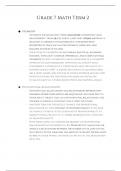Grade 7 Math Term 2
● Geometry
- Geometry (from Ancient Greek γεωμετρία (geōmetría) 'land
measurement'; from γῆ (gê) 'earth, land' and μέτρον (métron) 'a
measure') is a branch of mathematics concerned with
properties of space such as the distance, shape, size, and
relative position of figures.
- The 8 types of geometry are Euclidean, Elliptical, Algebraic,
Discrete, Topology, Complex, Hyperbolic, and Computational
geometry. Elliptic geometry is an illustration of a geometry
in which Euclid's resemblant hypothetical doesn't hold.
- For example: A triangle is a 3 sided shape, and the sum of its 3
interior angles is 180˚ A square, rectangle or quadrilateral
are 4 sided shapes, and the sum of their 4 interior angles is 360˚
Other polygons like the pentagon, hexagon, heptagon,
octagon have 5, 6, 7, 8 sides respectively and varying angles.
● Proportional Relationships
- Proportional relationships are relationships between two
variables where their ratios are equivalent. Another way to
think about them is that, in a proportional relationship, one
variable is always a constant value times the other.
- Another term for the rate of change for proportional
relationships is the constant of proportionality. If the rate
of change is then so is the constant of proportionality. To
simplify things, we set y x = k , where represents the constant
of proportionality
- Now, we're going to consider an example of proportional
relationship in our everyday life: When we put gas in our car,
there is a relationship between the number of gallons of fuel
that we put in the tank and the amount of money we will have
to pay. In other words, the more gas we put in, the more money
we'll pay.




